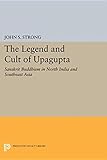The Legend and Cult of Upagupta : Sanskrit Buddhism in North India and Southeast Asia / John S. Strong.
Material type: TextSeries: Princeton Legacy Library ; 5019Publisher: Princeton, NJ : Princeton University Press, [2017]Copyright date: ©1992Description: 1 online resource (408 p.)Content type:
TextSeries: Princeton Legacy Library ; 5019Publisher: Princeton, NJ : Princeton University Press, [2017]Copyright date: ©1992Description: 1 online resource (408 p.)Content type: - 9781400887149
- 294.3/092 20
- BQ992.P34S76 1991
- online - DeGruyter
| Item type | Current library | Call number | URL | Status | Notes | Barcode | |
|---|---|---|---|---|---|---|---|
 eBook
eBook
|
Biblioteca "Angelicum" Pont. Univ. S.Tommaso d'Aquino Nuvola online | online - DeGruyter (Browse shelf(Opens below)) | Online access | Not for loan (Accesso limitato) | Accesso per gli utenti autorizzati / Access for authorized users | (dgr)9781400887149 |
Browsing Biblioteca "Angelicum" Pont. Univ. S.Tommaso d'Aquino shelves, Shelving location: Nuvola online Close shelf browser (Hides shelf browser)

|

|

|

|

|

|

|
||
| online - DeGruyter The Pleasure Gardens of Virginia : From Jamestown to Jefferson / | online - DeGruyter The Play of Power : Mythological Court Dramas of Calderon de la Barca / | online - DeGruyter Stoics and Neostoics : Rubens and the Circle of Lipsius / | online - DeGruyter The Legend and Cult of Upagupta : Sanskrit Buddhism in North India and Southeast Asia / | online - DeGruyter Neo-Baroque : A Sign of the Times / | online - DeGruyter Principles and Proofs : Aristotle's Theory of Demonstrative Science / | online - DeGruyter The Imaginative Landscape of Christopher Columbus / |
Frontmatter -- Contents -- Figures and Tables -- Preface -- Note and Abbreviations -- Introduction -- PART ONE. Upagupta in India -- CHAPTER ONE. Provisions for the Buddha's Absence -- CHAPTER TWO. Monk and Monkey: Upagupta's Karmic Past -- CHAPTER THREE. Birth and Lineage, Patriarchs, and the Forest-Monk Tradition -- CHAPTER FOUR. Lay Life, Ordination, and Arhatship -- CHAPTER FIVE. Upagupta and Mara: Bhakti and the Buddha Body -- CHAPTER SIX. Master-Disciple Relations -- CHAPTER SEVEN. Upagupta and Ásoka -- PART TWO. Upagupta in Southeast Asia -- CHAPTER EIGHT. The Southeast Asian Context: Upagupta and Theravada Orthodoxy -- CHAPTER NINE. The Lokapaññatti Legend -- CHAPTER TEN. Mythic Elaborations and Ritual Developments -- CHAPTER ELEVEN. Upagupta and the Arhat Cults -- CHAPTER TWELVE. Communal Cults: Upagupta as Protector of Festivals -- CHAPTER THIRTEEN. Personal Rewards and Domestic Rites -- Conspectus and Conclusion -- Notes -- Glossary -- Bibliography of Works Cited -- Index
restricted access online access with authorization star
http://purl.org/coar/access_right/c_16ec
The Buddhist monk Upagupta, who preached and taught meditative practices in Northwest India over two thousand years ago, is venerated today by the laity in parts of Burma, Thailand, and Laos as a protective figure endowed with magical powers. In this monumental work John Strong offers a systematic presentation of the Indian and Southeast Asian legends and rituals surrounding this popular saint. Once considered by Buddhist authorities as only marginally important, Upagupta emerges here as a central, ubiquitous figure within the Buddhist world. The author demonstrates the remarkable continuity among traditions focused on Upagupta in ancient Sarvastivadin Sanskrit materials, key Pali texts, medieval Thai and Burmese texts, and contemporary oral traditions and religious rituals in Southeast Asia. In so doing he reflects the orientation of popular Sanskrit Hinayana Buddhism, which allows for new perspectives on such classic questions as the nature of enlightenment, the role of asceticism, the problem of evil, the worship of the Buddha image, the veneration of saints, master-disciple relationships, the treatment of heterodoxy, and the relation of myth and ritual.Originally published in 1992.The Princeton Legacy Library uses the latest print-on-demand technology to again make available previously out-of-print books from the distinguished backlist of Princeton University Press. These editions preserve the original texts of these important books while presenting them in durable paperback and hardcover editions. The goal of the Princeton Legacy Library is to vastly increase access to the rich scholarly heritage found in the thousands of books published by Princeton University Press since its founding in 1905.
Mode of access: Internet via World Wide Web.
In English.
Description based on online resource; title from PDF title page (publisher's Web site, viewed 24. Aug 2021)


